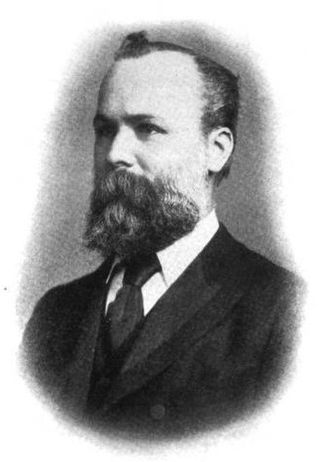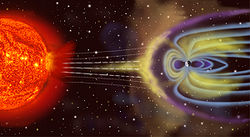
Sunspots are temporary spots on the Sun's surface that are darker than the surrounding area. They are one of the most recognizable Solar phenomena and despite the fact that they are mostly visible in the solar photosphere they usually affect the entire solar atmosphere. They are regions of reduced surface temperature caused by concentrations of magnetic flux that inhibit convection. Sunspots appear within active regions, usually in pairs of opposite magnetic polarity. Their number varies according to the approximately 11-year solar cycle.

The Maunder Minimum, also known as the "prolonged sunspot minimum", was a period around 1645 to 1715 during which sunspots became exceedingly rare. During the 28-year period 1672–1699 within the minimum, observations revealed fewer than 50 sunspots. This contrasts with the typical 40,000–50,000 sunspots seen in modern times over a similar timespan.

An aurora , also commonly known as the northern lights or southern lights, is a natural light display in Earth's sky, predominantly seen in high-latitude regions. Auroras display dynamic patterns of brilliant lights that appear as curtains, rays, spirals, or dynamic flickers covering the entire sky.

Space weather is a branch of space physics and aeronomy, or heliophysics, concerned with the varying conditions within the Solar System and its heliosphere. This includes the effects of the solar wind, especially on the Earth's magnetosphere, ionosphere, thermosphere, and exosphere. Though physically distinct, space weather is analogous to the terrestrial weather of Earth's atmosphere. The term "space weather" was first used in the 1950s and popularized in the 1990s. Later, it prompted research into "space climate", the large-scale and long-term patterns of space weather.

A geomagnetic storm, also known as a magnetic storm, is a temporary disturbance of the Earth's magnetosphere caused by a solar wind shock wave.

Edward Walter Maunder was a British astronomer. His study of sunspots and the solar magnetic cycle led to his identification of the period from 1645 to 1715 that is now known as the Maunder Minimum.

Balfour Stewart was a Scottish physicist and meteorologist.
The following is a chronology of discoveries concerning the magnetosphere.

Annie Scott Dill Maunder was an Irish-British astronomer, who recorded the first evidence of the movement of sunspot emergence from the poles toward the equator over the Sun's 11-year cycle. She was one of the leading astronomers of her time, but because of her gender, her contribution was often underplayed at the time. In 1916 she was elected to the Royal Astronomical Society, 21 years after being refused membership because of her gender.

Elias Loomis was an American mathematician. He served as a professor of mathematics and natural philosophy at Western Reserve College, the University of the City of New York and Yale University. During his tenure at Western Reserve College in 1838, he established the Loomis Observatory, currently the second oldest observatory in the United States.

Solar cycle 24 is the most recently completed solar cycle, the 24th since 1755, when extensive recording of solar sunspot activity began. It began in December 2008 with a minimum smoothed sunspot number of 2.2, and ended in December 2019. Activity was minimal until early 2010. It reached its maximum in April 2014 with a 23 months smoothed sunspot number of 81.8. This maximum value was substantially lower than other recent solar cycles, down to a level which had not been seen since cycles 12 to 15 (1878-1923).
This is an index to articles about terms used in discussion of radio propagation.

The Carrington Event was the most intense geomagnetic storm in recorded history, peaking on 1–2 September 1859 during solar cycle 10. It created strong auroral displays that were reported globally and caused sparking and even fires in telegraph stations. The geomagnetic storm was most likely the result of a coronal mass ejection (CME) from the Sun colliding with Earth's magnetosphere.

The three-day May 1921 geomagnetic storm, also known as the New York Railroad Storm, was caused by the impact of an extraordinarily powerful coronal mass ejection on Earth's magnetosphere. It occurred on 13–15 May as part of solar cycle 15, and was the most intense geomagnetic storm of the 20th century.

Solar cycle 25 is the current solar cycle, the 25th since 1755, when extensive recording of solar sunspot activity began. It began in December 2019 with a minimum smoothed sunspot number of 1.8. It is expected to continue until about 2030.
Solar observation is the scientific endeavor of studying the Sun and its behavior and relation to the Earth and the remainder of the Solar System. Deliberate solar observation began thousands of years ago. That initial era of direct observation gave way to telescopes in the 1600s followed by satellites in the twentieth century.

Solar phenomena are natural phenomena which occur within the atmosphere of the Sun. They take many forms, including solar wind, radio wave flux, solar flares, coronal mass ejections, coronal heating and sunspots.

The 25–26 January 1938 geomagnetic storm was a massive solar storm which occurred 16–26 January with peak activity on 22, 25, and 26 January and was part of the 17th solar cycle. As the electrification of Europe and North America was still in its infancy, the light storm could be seen brilliantly. The intensely bright arches of crimson light with shifting spectrum of green, blue-white, and red radiated from a brilliant auroral crown near the zenith instead of appearing as usual in parallel lines. This aurora is believed by many people, especially those of the Catholic faith, to be related to the Fátima Prophecies.

A space hurricane is a huge, funnel-like, spiral geomagnetic storm that occurs above the polar Ionosphere of Earth, during extremely quiet conditions. They are related to the aurora borealis phenomenon, as the electron precipitation from the storm's funnel produces gigantic, cyclone-shaped auroras. Scientists believe that they occur in the polar regions of planets with magnetic fields.















